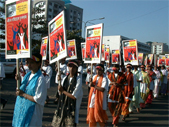|
Module 5: Tools for Mainstreaming Gender in Transport
5.5. Social and Community Mobilization

Photo courtesy of Photoshare.
- Uses community events to attract the attention of policy makers,
community members, and media representatives and motivate them to
take action on a specific issue such as HIV/AIDS, road safety, or
local infrastructure planning.
- Amplifies advocacy activities, strengthens communication, and allows
many more stakeholders to participate in the program.
- Creates broad ownership and popular support as information is made
available and understandable to both experts and the general public.
Social Mobilization Principles
- Communication is an integral part of the social mobilization process
for gender and transport.
- Access to evidence-based information on gender differences in transport
access and needs is fundamental to behavior change and collective
action efforts.
- Social mobilization strategies need to be tailored to the local
setting.
- Capacity building for social mobilization involves "learning by
doing."
- Social mobilization efforts must provide a safe environment for
diverse stakeholders at all levels to engage in dialogue and collaborative
actions on gender and transport.
- Social mobilization requires a paradigm shift away from the focus
on individual change to holistic social change.
- While social mobilization for gender and transport may be initiated
at a variety of levels, ownership of the process must be at the local
level and tailored to local culture.
Community Mobilization Cycle
- Prepare to mobilize: identify the transport issues and community
needs, identify resources and constraints, establish a team, and develop
a plan.
- Organize the community for action: orient, build relations, invite
participation, develop a core group.
- Explore issues and set priorities: starting with core group and
moving to wider community.
- Plan together: set objectives, roles and responsibilities, facilitate
community action plan.
- Act together: define your team's role, build community capacity,
monitor progress, advise and troubleshoot.
- Evaluate together: develop plan and conduct participatory evaluation,
share findings with community.
- Prepare to scale up: assess potential to scale up, build capacity,
seek funding.
Community Mobilization Resources
See Module 6 for a complete listing of gender and transport resources
organized by type of resource and issues. The list below includes resources
on topics presented in this section of Module 5.
|